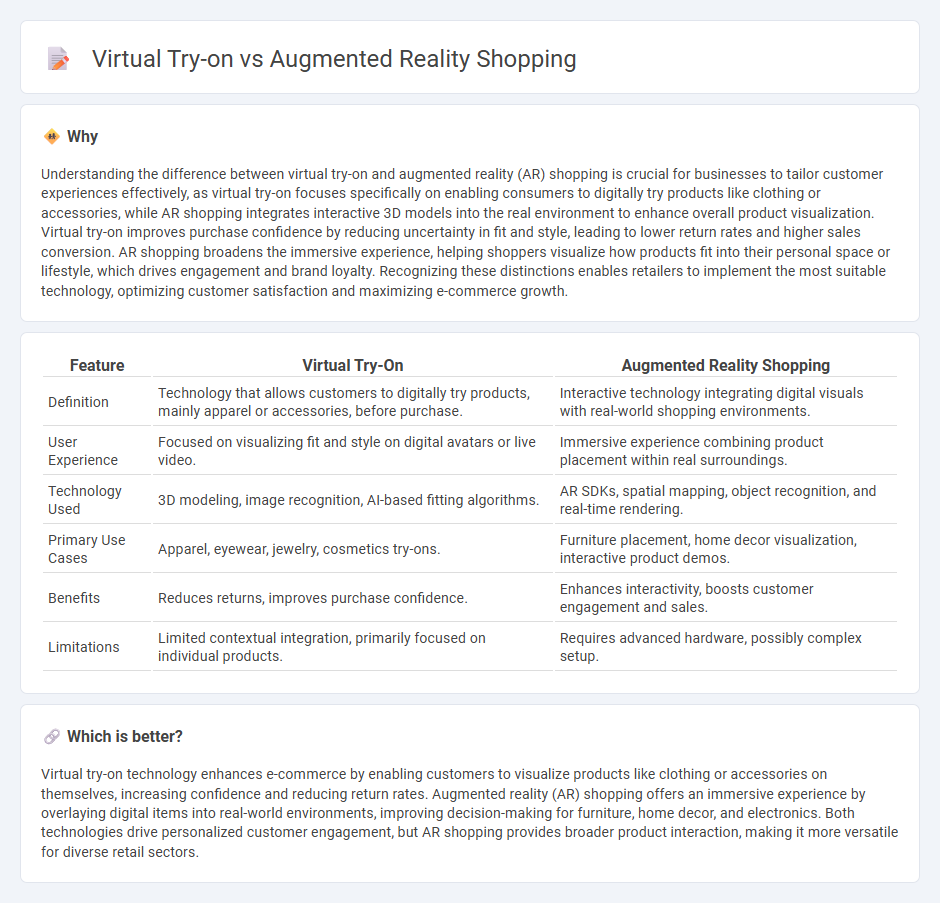
Virtual try-on technology enables consumers to digitally visualize products like clothing and accessories on themselves using personalized avatars, enhancing the online shopping experience through accurate fit and style previews. Augmented reality shopping integrates digital elements into real-world environments, allowing users to interact with products within their physical space via smartphones or AR glasses. Explore the latest advancements and benefits of virtual try-on and augmented reality shopping to revolutionize your retail experience.
Why it is important
Understanding the difference between virtual try-on and augmented reality (AR) shopping is crucial for businesses to tailor customer experiences effectively, as virtual try-on focuses specifically on enabling consumers to digitally try products like clothing or accessories, while AR shopping integrates interactive 3D models into the real environment to enhance overall product visualization. Virtual try-on improves purchase confidence by reducing uncertainty in fit and style, leading to lower return rates and higher sales conversion. AR shopping broadens the immersive experience, helping shoppers visualize how products fit into their personal space or lifestyle, which drives engagement and brand loyalty. Recognizing these distinctions enables retailers to implement the most suitable technology, optimizing customer satisfaction and maximizing e-commerce growth.
Comparison Table
| Feature | Virtual Try-On | Augmented Reality Shopping |
|---|---|---|
| Definition | Technology that allows customers to digitally try products, mainly apparel or accessories, before purchase. | Interactive technology integrating digital visuals with real-world shopping environments. |
| User Experience | Focused on visualizing fit and style on digital avatars or live video. | Immersive experience combining product placement within real surroundings. |
| Technology Used | 3D modeling, image recognition, AI-based fitting algorithms. | AR SDKs, spatial mapping, object recognition, and real-time rendering. |
| Primary Use Cases | Apparel, eyewear, jewelry, cosmetics try-ons. | Furniture placement, home decor visualization, interactive product demos. |
| Benefits | Reduces returns, improves purchase confidence. | Enhances interactivity, boosts customer engagement and sales. |
| Limitations | Limited contextual integration, primarily focused on individual products. | Requires advanced hardware, possibly complex setup. |
Which is better?
Virtual try-on technology enhances e-commerce by enabling customers to visualize products like clothing or accessories on themselves, increasing confidence and reducing return rates. Augmented reality (AR) shopping offers an immersive experience by overlaying digital items into real-world environments, improving decision-making for furniture, home decor, and electronics. Both technologies drive personalized customer engagement, but AR shopping provides broader product interaction, making it more versatile for diverse retail sectors.
Connection
Virtual try-on technology leverages augmented reality (AR) to overlay digital images of products, such as clothing or accessories, onto a shopper's real-time image, enhancing the online shopping experience. This integration of AR in commerce reduces return rates by enabling customers to visualize items accurately before purchase, increasing confidence and satisfaction. Retailers adopting virtual try-on solutions benefit from higher engagement and conversion rates, aligning with trends in immersive digital commerce.
Key Terms
Immersive Experience
Augmented reality shopping enhances the immersive experience by seamlessly integrating digital elements into the physical environment, allowing customers to visualize products in real-world contexts. Virtual try-on technology focuses on providing a realistic and interactive way for users to experiment with items like clothing or accessories through precise digital overlays. Explore more about how these immersive technologies revolutionize consumer interaction and decision-making.
Product Visualization
Augmented reality shopping enhances product visualization by integrating 3D models into real-world environments, allowing consumers to see items in their actual space before purchase. Virtual try-on technology focuses on personalized visualization, enabling users to digitally wear or use products like clothing, accessories, or cosmetics for a realistic preview. Explore deeper insights on how these technologies revolutionize the online shopping experience.
Personalization
Augmented reality shopping enhances personalization by integrating real-time data with users' environmental context, providing immersive and interactive product experiences tailored to individual preferences. Virtual try-on technologies focus on customized fitting and styling by using AI-driven body mapping and facial recognition to simulate products accurately on a user's image. Explore further to understand how these innovations redefine personalized shopping experiences.
Source and External Links
AR Shopping: Top Trends and Apps for the Future (2024) - Shopify - Augmented reality shopping lets customers virtually try on or test products via smartphones or VR headsets, transforming ecommerce by enabling immersive pre-buy interactions and is projected to generate significant market value by 2030.
Top 5 Augmented Reality Apps that Created Immersive Shopping Experiences - Artlabs - AR apps enhance shopping by allowing customers to visualize products within their real-world environment, improving confidence and reducing returns through an immersive try-before-you-buy experience.
10 of the Best Augmented Reality (AR) Shopping Apps to Try Today - Leading retailers like Target, Sephora, and Warby Parker use augmented reality apps to let customers preview furniture in their homes or virtually try on makeup and glasses, revolutionizing how shoppers interact with products.
 dowidth.com
dowidth.com